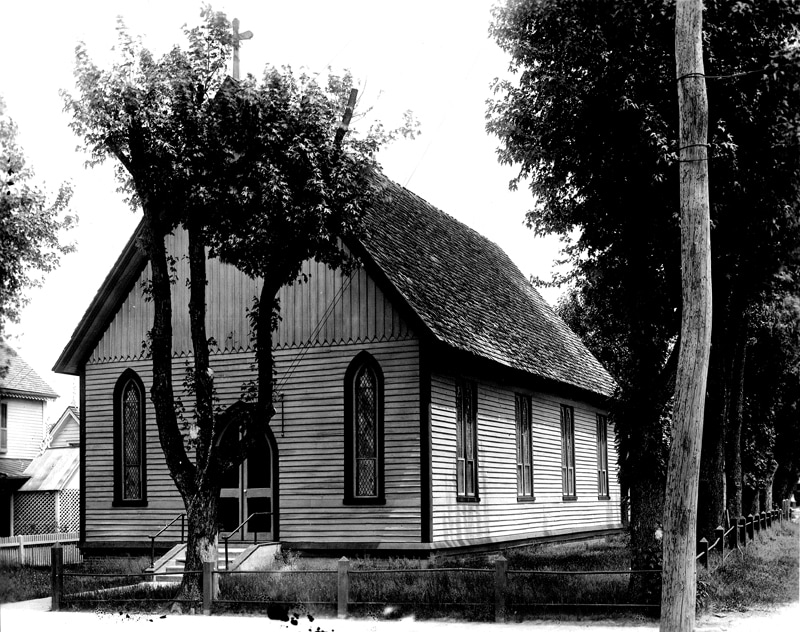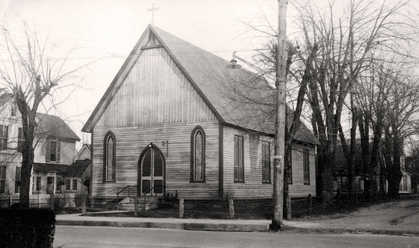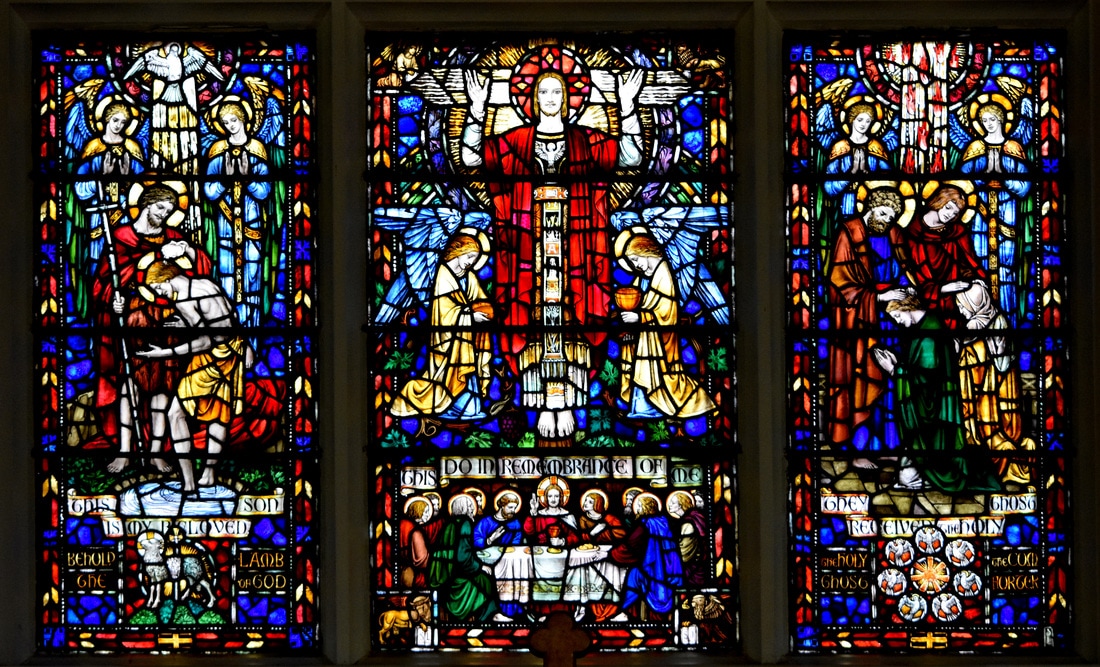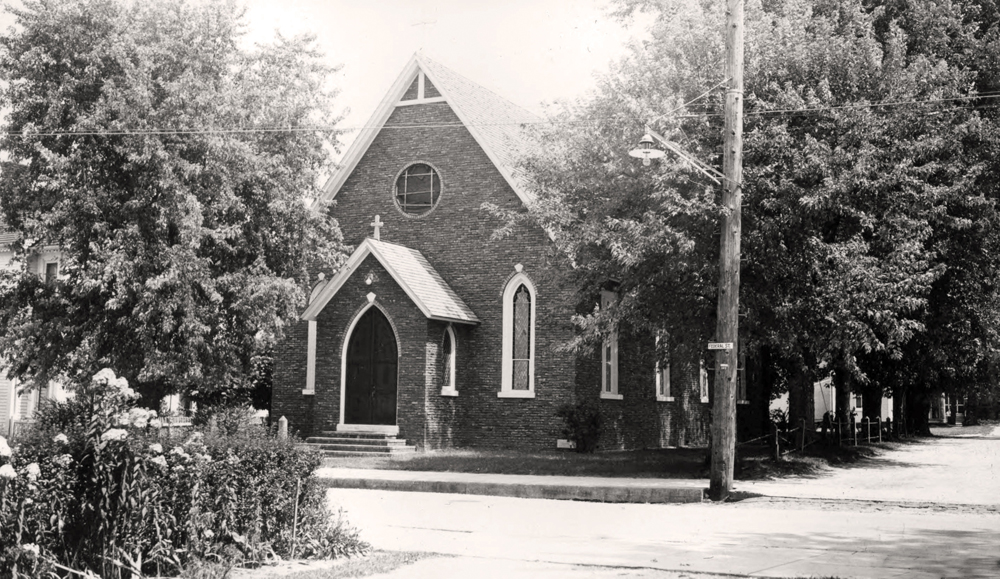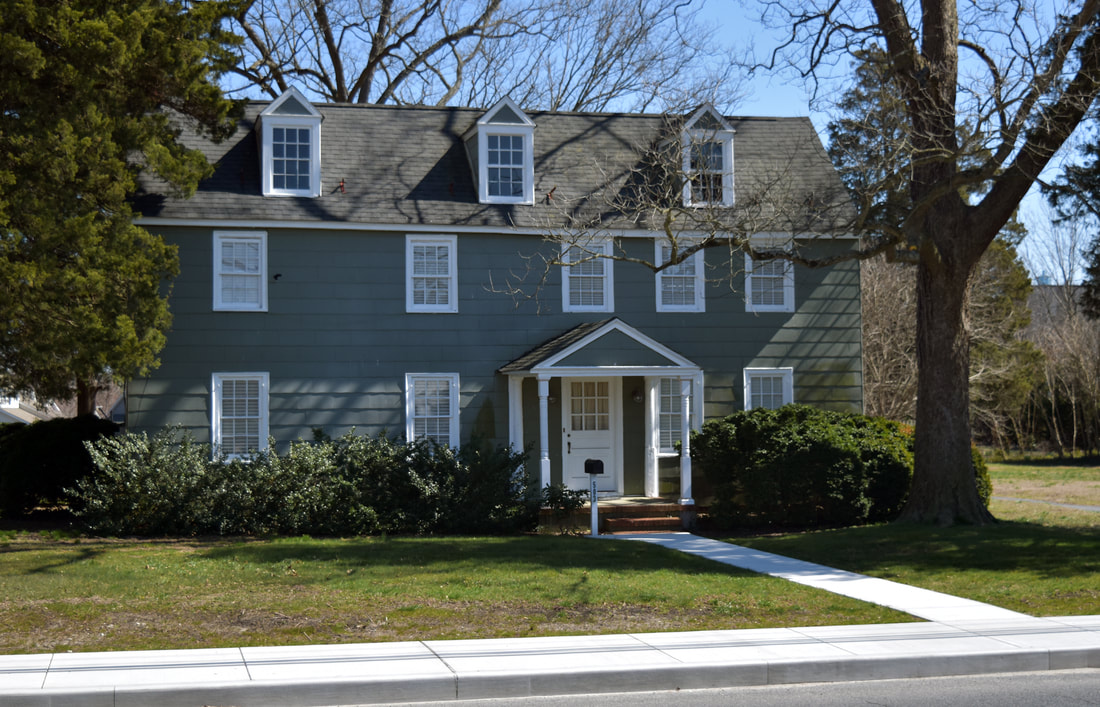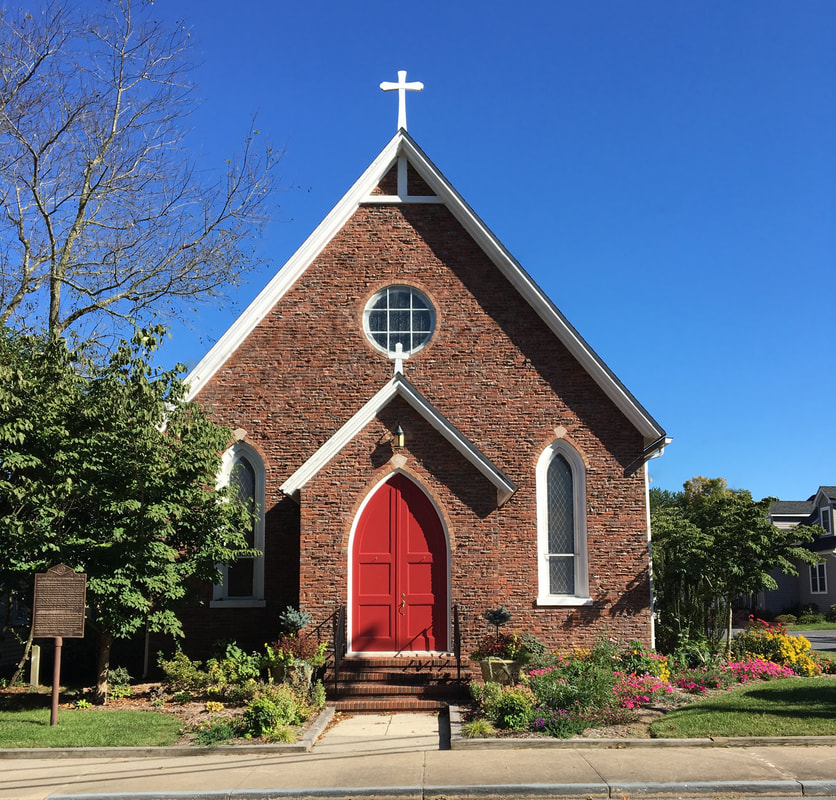The Episcopal Church of St. John the Baptist: A Timeline
|
March 27, 1728--Construction begins on the original church building "in the wilderness," according to a report by The Rev. William Becket, an Anglican missionary from the Society for the Propagation of the Gospel in Foreign Parts. He writes in October, "St. John Baptists church was raised on Wednesday the 27th of March 1728. The frame is of white Oak, the dimensions are as follows, viz. 30 feet long 20 broad & 12 feet between the plate and sill. It stands about the Center of the county in the forest of Sussex and is inscribed to St. John the Baptist. The covering of the wall is to be of Cypress board and the roof of shingles of the same wood which is most used here for like purposes as the rain will not cause it to Rot. The work is being carry'd on by voluntary contribution of the inhabitants as it has already been raised on that foundation."
It is believed Fr. Becket chose St. John the Baptist, "the voice of one crying in the wilderness," as the patron saint because the church itself was "in the wilderness," in his words. It was some two miles southwest of the present location, and despite being "in the wilderness," it was on the main thoroughfare--then called King's Highway, now Gravel Hill Road/Route 30--leading south to southern Sussex and Maryland. (GPS location: 38.74276° -75.32863°.) Fr. Becket, as part of his "Sussex Mission," had earlier founded St. Peter's, Lewes; St. Matthew's, Cedar Creek Hundred; and St. George's Chapel, Indian River Hundred. Circa October 1728--The building is completed and consecrated. September 25, 1729--Fr. Becket reports, "My churches are in a growing condition, and a fourth church, built in a forest, was opened by me about a year ago, by the name of St. John The Baptist...There is likely to be a numerous congregation there." September 26, 1742--Fr. Becket reports that his four churches are filled on Sundays and holy days, and that in summertime, as they are unable to hold the congregations, he is often obliged to preach "under the green trees." August 20, 1743--Fr. Becket dies and is buried at St. Peter's, Lewes, having spent his entire ministry serving the Sussex Mission. Summer 1744--Mr. Benjamin Mifflin of Philadelphia visits and stays with Mr. John Clowes Jr., who lives in "the village on the Broadkill" (Milton). Mr. Mifflin writes that he and Mr. Clowes walked about a mile and a half to attend "the English Church" (St. John the Baptist), and in the absence of clergy, Mr. Clowes "read the Church service and a sermon out of Hervey." April 4, 1745--The Rev. Arthur Ussher, also a missionary with the Society for the Propagation of the Gospel in Foreign Parts but serving in Dover, Delaware, becomes the priest at St. Peter's, Lewes, which was overseeing St. John the Baptist. Fr. Ussher at this time is the only Anglican priest in all of Sussex County. 1774--The Rev. Samuel Lyon refers to the 46-year-old building as "an old ruinous church." April 19, 1775 to September 3, 1783--The Revolutionary War is fought. The "American Revolution left the Anglican parishes shattered, stripped of most of their financial support, weakened by the flight of many clergy and thousands of members, with a number of buildings destroyed and property lost," according to Powell Mills Dawley in Our Christian Heritage (Morehouse-Gorham, 1959). 1790--A meeting is held to raise funds to support The Rev. William Skelly, who would preside one Sunday each month at Cedar Creek Hundred, Dagsboro, Indian River Hundred, Broad Creek Hundred and Milton--the arrangement presumably working best when months have five Sundays. 1795--The Rev. James Wiltbank arrives and the above circuit is ended. 1799--Regular worship is discontinued 25 years after the building was called "an old ruinous church," but the structure is used as a school until 1838. 1802--The land at the current location is purchased from the heirs of Mr. William Coulter for a new church building, but construction will not begin for another 73 years. July 1838--The Rev. Cory Chambers reports he helped revive the Milton congregation. Services are held in other area churches and in the old building, which is now being used by the Methodist Protestants, whose church in Milton would not be built until 1857. The MPs had renamed the old church "St. Mary's." This is the last known use of the old building, and by 1868, a map drawn of the area shows no church building. June 16, 1840--Fr. Chambers, having relocated to Maryland in November 1838, is finally paid in full for his simultaneous service to Milford, Cedar Creek Hundred, Seaford, Laurel, Little Hill and Milton. For all that, his annual salary in Delaware had been $200. May 24, 1847--The Articles of Association are signed, legally creating an Episcopal parish named St. John the Baptist under American law. The communicants, without a church building, meet in the Milton Academy, and there will be no resident priest for many years. The Rt. Rev. Dr. Alfred Lee, first bishop of the Diocese of Delaware, and various missionaries visit and preach to the parishioners from time to time. 1864--The Rev. Dr. J. Leighton McKim leads Episcopal worship for the St. John the Baptist communicants in Milton's Methodist Protestant church. He was known to walk frequently between Milton and Milford in performing his pastoral duties. 1867--The parish is formally reestablished but is mistakenly called "St. Mary's," which the Methodist Protestants had renamed the old church (see July 1838, above). The congregation is described as "large and attentive." 1875--The patron saint reverts to St. John the Baptist and construction of the present building begins. June 5, 1877--The building, completed, is consecrated by Bp. Lee and Fr. McKim. In his remarks, Bp. Lee states that if a church had been erected sooner in Milton "many persons would have been retained within our fold who have sought other ministrations." The structure is 30 feet by 56 feet, sided with cypress clapboard, and built at a cost of $2,500. Autumn 1881--The Rev. Frederick Thompson, the "bishop's missionary" to St. John the Baptist, organizes a boys' boarding school, which is later relocated to Faulkland, Delaware, but closed in 1886. December 6, 1905--The News Journal reports "a peculiar condition existing in the choir" of St. John the Baptist. "On November 5th a surpliced choir of 12 boys was established and all the boys are of Methodist Episcopal parentage." 1907 to 1908--The parish conducts a mission in Ellendale, a poor, largely African-American community. March 12, 1915--Bp. Frederick J. Kinsman consecrates the bishop's chair presented by the children of Mr. Nehemiah D. and Mrs. Mary P. Welch. Mr. Welch had been a warden at St. John the Baptist for a quarter of a century. 1918--Full criteria for a "parish" no longer obtaining, the diocese unilaterally reduces St. John the Baptist from "parish" to "organized mission"--but at least not to "unorganized mission," the third possible category. Six other parishes in this period also are reduced to organized missions, but unlike St. John the Baptist, they voluntarily applied for organized mission status. St. John the Baptist will remain a mission (so with a vicar, not a rector) into the 1990s. 1929--The stained-glass altar window is installed as a bequest of U.S. Sen. Willard Saulsbury in memory of his mother, Milton native Mrs. Annie Ponder Saulsbury. It was designed by Mr. James H. Hogan of London, and constructed by James Powell & Sons in the White Friars Glass Works in England. Sen. Saulsbury's will also called for windows from the same source to be installed in Trinity Church, Wilmington; Christ Church, Dover; and St. Paul's, Georgetown. 1936--The church is completely remodeled, including the placing of clinker brick as a veneer to the building, the addition of the narthex, and new wooden flooring. January 17, 1937--The improvements are consecrated by The Rt. Rev. Philip Cook. October 6, 1941--The newly constructed adjoining parish hall is consecrated by The Rt. Rev. Arthur R. McKinstry and The Rev. Benjamin F. Thompson. 1942 to 1948--With no vicar at St. John the Baptist, lay reader Mr. George S. Buhl serves as worship leader and much more. Bp. McKinstry writes Mr. Buhl on April 20, 1944: "I want to thank you for the beautiful service at Milton Sunday. I really enjoyed it as much as any I have attended in a long while. Can't you get someone to relieve you of some of your work? It doesn't look dignified to see you chasing around, playing the organ, and trying to keep everything going. However, sincerely I was very much impressed." A vicar is finally supplied in 1949. September 1948--Mr. Buhl's idea to hold dances in the parish hall for high school students is furthered by an offer from the Ladies' Auxiliaries of the American Legion and the V.F.W. to assist. Created so that young people would not have to leave Milton on Friday evenings for entertainment, the dances would continue at least through 1969. Circa 1950-1970--The parish owns a vicarage at 503 Chestnut Street, Milton (pictured). It was purchased with money from the bequest of U.S. Sen. Willard Saulsbury (see the entry for 1929 above.) 
March 7, 1965--The Rev. Laurence H. Miller, vicar of St. John the Baptist, along with six other Episcopal priests from Delaware, answer The Rev. Dr. Martin Luther King Jr.'s appeal "calling on religious leaders all over the nation to join us on Tuesday in our peaceful, nonviolent march for freedom." The appeal was made in the wake of the March 7 "Bloody Sunday," when, on the Edmund Pettus Bridge in Selma, Alabama, state troopers attacked with clubs and tear gas those who were peacefully marching to Montgomery in support of racial equality. Nearly 40 Delaware Episcopal priests had volunteered to go, so names were drawn from a hat for six of the seven vacancies, Fr. Miller being one of the six. He and the other priests flew to Selma for this second march on March 9, in which The Rev. King led 2,000 people, including hundreds of clergy members. Faced with a federal restraining order against the march and pressure from President Johnson, The Rev. King led his followers to the Edmund Pettus Bridge and asked them to kneel and pray. After prayer, they rose and redirected the march back to Selma instead of pushing forward to Montgomery. In so doing, they likely avoided more bloodshed, but more significantly, their restraint gained the support of President Johnson, who promised to introduce a voting rights bill to Congress within a few days. On March 17 he did so, and in time it became law.
1973--St. John the Baptist purchases 309 Federal Street, a neighboring residence built by Mr. George B. Atkins, to use for Sunday School and meetings. Mr. Charles G. "Parky" Jones Jr., assisted by Mr. Millard Jenkins, builds a replica of the church's altar for the building to facilitate worship in Sunday School and training of acolytes.
1982--The church is a contributing building in the Milton Historic District, which is listed in the National Register of Historic Places. 2002--Along the sunny, south wall of the church a memorial garden is created, providing for interment of ashes of the deceased. 2011--To accommodate an increasing number of worshipers, St. John the Baptist acquires 113 Wharton Street and 315 Federal Street, razes a dilapidated building on the latter and creates a parking lot, which later will be blacktopped and landscaped. June 5, 2017--On the 140th anniversary of our present building's consecration, the parish presented the 1877 consecration document to the Delaware Public Archives for professionally managed archiving. It will always be available for public viewing. A high-resolution replica was created and continues on display in the parish hall. Today--St. John the Baptist is a thriving, all-inclusive parish (no longer a mission, see 1918, above) and an integral part of the greater Milton area. The parish anticipates soon celebrating the 300th year of its origin, with its charge the same as three centuries ago--sharing the love of God as revealed through Our Lord and Savior Jesus Christ! (Much of the above information is from Nelson Waite Rightmyer's The Anglican Church in Delaware, (c) 1947, The Church Historical Society; Charles A. Silliman's The Episcopal Church in Delaware, 1785-1954, (c) 1982, The Diocese of Delaware; Frank R. Zebley's The Churches of Delaware, (c) 1947, Delaware Public Archives; and from W. Howard Carey's Turning Back the Town Clock, self-published October 1973.) |
Circa 1907 or later. Electricity is in, but Federal Street is yet unpaved.
Courtesy of Delaware Public Archives Circa 1907 or later.
Courtesy of Delaware Public Archives Later than the above photo, but before 1936.
Courtesy of Delaware Public Archives Christmas at St. John the Baptist sometime before 1929
The baptism-themed altar window was installed in 1929.
The 1936 improvements are in place.
Courtesy of Delaware Public Archives In Lent, March 16, 1943.
Courtesy of Delaware Public Archives Circa 1949
The circa 1950-1970 vicarage at 503 Chestnut Street today
St. John the Baptist today
|


